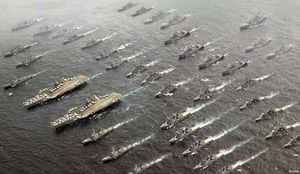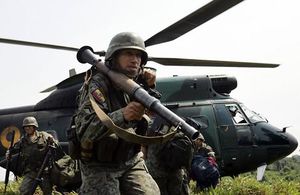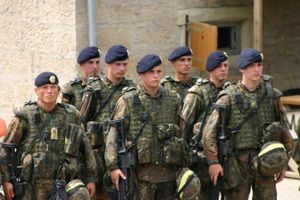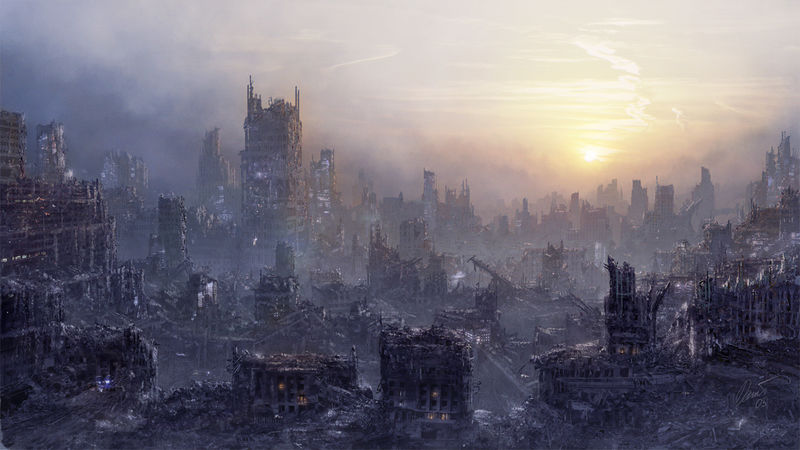European - United Hispanic States Empire War
“This won't end well for us”
– UHSE citizen upon hearing about the war
“We Surrender!!!!”
– The French on well...... everything
“YOUR MOM!!!”
– Josh on well.... just about everything
“We will be back in time to watch the French get there arses kicked by the Germans (in soccer)”
– British Troops upon getting orders to report for duty
“FALL BACK, FALL BACK!!! PROTECT THE RALLY POINT TACO BELL!!!”
– Mexican Commander Santa Anna Jr during the Battle of Little Taco Stand
In 2009 tensions between the UHSE (United Hispanic States Empire) and the European Union began to deteriorate following the Great Burrito Massacre, where 306 tourists died of Extremely Super-Duper Explosive Diarrhea caused by a mutated strain of Pissed-Off Cow Disease. When the UHSE refused to pay reparations to the victims families the European Union Armed Forces geared up for what they thought would be a quick decisive victory. What they didn't know was that they were heading into a war that would last 6 long years.
The EU Prepares for War[edit | edit source]
After the government of the UHSE refused to pay reparations to families of the victims the European Army was put on middle alert. (because really what are the Mexicans going to do?) While the European Marines and Army were preparing to launch an amphibious invasion from the Gulf of Mexico, the European Navy made ready to engage the Mexican Fleet in the Carribean, the Pacific, and the Great Lakes (Long story). The European ground forces were armed with state of the art equipment including:
- Land Krieger- a German version of the American Land Warrior system
- G36, L85A2, and AK-103 Assault Rifles (all equiped with either Tactical Scopes, Grenade Launchers, or forward Grips.)
- The MG-X a modern version of the MG-42 Machine Gun
- M1911 Handguns (more powerful than their normal handguns)
- P90 & MP7 SMGs
- American Barrett M82A1 .50 caliber Sniper
- Browning .50 caliber Heavy Machine Guns
- Marder APCs
- Armburst and Stinger Missile Launchers
- Lynx Attack/Transport Helicopters
- Leopard, Challenger, and T-90 MBTs, and
- Numerous other support vehicles I don't feel like naming
The UHSE Prepares for War[edit | edit source]
On The 34th of April the UHSE Army began building defenses along the coast while the civilians did what they do best, cross illegally into the U.S., The UHSE military consisted of 280 Divisions compared to the Europeans 245 Divisions. While Mexican equipment was less high tech than the Europeans it was slightly more durable, Weapons and Vehicles included:
- FN FAL, M16A3, G3 Assault Rifles
- Surplus WW2 German Luger Pistols & M9s they stole from America
- RPG-7s and LAW 66 Anti-Tank Weapons
- M1903 ECR (Enhanced Combat Rifle) Sniper Rifles
- Class-3 'Donkey' Quadripedal battlefield transport
- MP5 & Thompson SMGs
- RGD-5 Hand Grenades
- M-45B "Taco" MBT Tanks
- M113 APCs
- Mexican Made Mi-35 "Burrito" Helicopters (Destroyed by European Special Forces before the Invasion)
- PKM and M-60 Machine Guns
- a slice of toast
- a pencil sharpener
- a wind up torch
- again, numerous other weapons and vehicles I don't feel like naming
Invasion[edit | edit source]
On the morning of February 12, 2010 European Special Forces H.A.L.O.ed into areas of UHSE control to begin sabotaging military installations and and war material factories. These units consisted of SAS, KSK, Spetsnaz, Royal Irish Rangers, Special Brigade, and a highly classified Finnish Special Operations Detachment.
[edit | edit source]
As part of the Invasion force was approaching the city of Vera Cruz its escorts engaged UHSE Patrol Craft and elements of the UHSE 5th Fleet around 4 o'clock AM. The confrontation lasted approximately two hours and stalled the invasion long enough for the European Navy to retrieve European and UHSE sailors from the six ships sunk.
Ships Sunk:
European Navy Losses: EUS Indestructurmountable (Crusier)& EUS Berlin (Destroyer)
UHSE Navy Losses: UHSES Santa Anna (Aircraft Carrier), UHSES Rio de Janero (Crusier), UHSES Argentina (Cruiser), MPV 145 (Patrol/ Torpedo Boat, the pencil sharpener
This was the only major naval battle of the war.
On a side note: The piece of toast became soggy and was therefore useless to the UHSE.
Resistance to Initial Landings[edit | edit source]
As troops from the EU began to head for the beaches they came under heavy fire from UHSE 81mm Mortars as well as 120mm, 160mm, and 200mm Howitzers dug in and hidden near the landing zones. When they arrived within 100 yards of the beach machine gunners opened up with PKM and M-60 machine guns. Despite the guns age they inflicted terrible casualties on the 12th French Human Shield Corps and a few infantry men who happened to be in the wrong place at the wrong time. It took the European infantry three hours to fight their way to the safety of the former trenches of the UHSE.
European Union Meet Heavy Resistance Following the Initial Landings[edit | edit source]
After finally arriving at the the invasion points the Russian, German, and British soldiers prepared to storm the beaches at the three designated invasion points Vodka Beach (Russians), Beer Beach (Germans), and Scotch Beach (British). They would work their way up the beaches using a time proven method: Enticing Frenchmen up the beaches with cheese and onions first to act as human shields. After the landing beaches were secured troops from Finland, Serbia, and Ireland landed to reinforce the first wave. How ever this was only the beginning, they still had to take control of the key cities along the coast so more troops could be off-loaded and heavy equipment brought in.
Vera Cruz[edit | edit source]
After securing the formally UHSE controlled beaches the EU infantry waited six hours to reorganize, resupply, and get some sleep because before them lay the task of rooting out the defenders of the once tourist filled Mexican resort city. It would consist of house to house fighting that would come to rival the battle of Stalingrad in brutality, it would take four months to finally gain control of the city. The Battle of Vera Cruz (later known as "Mexico's Stalingrad) would claim over 1 million lives 78% would be soldiers from the UHSE and EU while the other 22% would consist of civilians caught in the crossfire.
Rio de Janeiro[edit | edit source]
The second major city to fall to EU's invasion (Buenos Aires fell after seven hours of fighting) it would hold out for three weeks of fighting (February 18th until March 3rd) until Russian, British, and Finnish paratroopers dropped in around the city and cut of its supplies, effectively ending the battle of Rio de Janerio. Although it would later become a hub of insurgent activity later in the war as EU forces approached the heavily defended UHSE capital, Trinadad.
Montevideo[edit | edit source]
while Montevideo was only able to resisted the EU invasion for a little over a month it would become infamous after its local garrison comander Hernando Ramiraz Gonzalez dissobeyed orders and unleashed chemical weapons on the attacking troops and refused to allow civilians to evacuate the city and forced them to help defend the city even though the situation was already hopeless.
The Belo Horizonte Massacre[edit | edit source]
On August 23rd, EU Forces were bogged down shortly after leaving the major cities to passify the towns and villages located with the Amazon Rain forest and the interior of Mexico and Central America. On October a patrol of Serbian and Irish soldiers arrived in the town of Belo Horizonte to question the locals about local insurrgent activity. (by this time the regular UHSE Army had fallen back to a defensive line running down the middle of South America) The soldiers did what they usually did, question the the local elected officials and townspeople and were preparing to leave when all of a sudden a shot rang out and the unit commander, Sean McLeary fell to the ground unconscious. (his helmet stopped the bullet) At this time a local partisan milita opened fire on the company even though there were still a number of civilians in the streets between them and the soldiers. By the end of the brief but bloody battle 83 civilians, 5 soldiers and 14 insurgents were dead.
The Siege of Mexico City[edit | edit source]
On December 20th EU forces approached the regional capital of Mexico City. The assault force consisted of 12 Divisions + Armor, Artillery, and Support Units. The Defenders consisted of 14 divisions + artillery and support units but no armor. (most was sent to reinforce Vera Cruz and other positions and was either captured, destroyed, or unable to return because of the rapid European advance. The European troops through up a cordon around the city and prepared to starve the enemy out, it would take three and a half years.
Europeans: The Europeans established a perimeter around the city consisting of Watch Towers, Barb Wire Fences, Minefields, Pillboxs, and kept the city under a state of sporadic artillery barrage.
Civilians and Soldiers in the City: During the siege the only true safe zone was at the city center which quickly became over crowded and was in an almost constant state of violence due to lack of food, water, and other basic ammenites. 2.3 million soldiers died during the siege and 4.6 million civilians died during the siege.
Aftermath: The siege ended July 20th, 2013 when the remnants of the UHSE's garrison and defenders staggered out of the ruined city to be taken to POW camps on the island of Grenada. (Controlled by EU) European troops distributed food, water, clothing, and other items to the civilians in the city.
The C.S.A Joins the War[edit | edit source]
In the closing years of the war the UHSE became desperate and began attacking countries friendly to the EU, specifically the C.S.A. because it allowed EU troops to go there on leave. On September 12th, 2013 a commando unit from the UHSE detonated a tactical nuclear device in the C.S.A.'s financial capital Charolette, NC. With some coaxing from the EU instead of Nuking the UHSE back into the stone age they sent in 8 Divisions to reinforce EU units already in the field.
- The above photo is post-nuclear strike Charolette, NC




